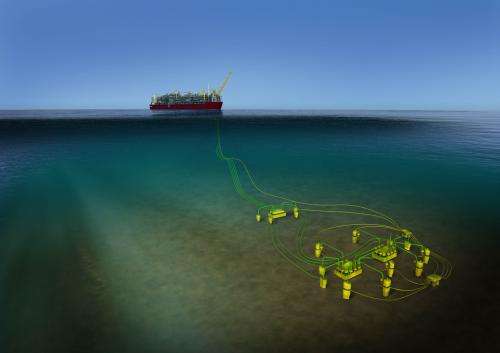Mobile foundations the key to unlocking offshore reserves

The offshore energy industry is a market sector that must remain innovative to stay competitive to secure Australia's energy future.
Latest statistics show Australia's total petroleum output has an annual export sales value of more than A$25-billion and annual taxation payments by the industry of more than A$8-billion.
One of the challenges the industry faces though is unlocking the huge hydrocarbon reserves located offshore Australia and elsewhere, that are currently unreachable.
Australian research and development into mobile foundation technology is one piece of the jigsaw.
What are mobile foundations?
The term "mobile foundation" may seem an oxymoron – we typically expect foundations, and the structures they support, to remain stationary. It would be alarming if our homes or office buildings started to wander, but we accept that ocean-going vessels experience stability and mobility concurrently.
The concept of a mobile foundation is similar to a snow sleigh or ski. It's a foundation that is engineered to slide or glide across the seabed to absorb some of the applied loads, rather than simply being engineered big enough to resist the loads and remain stationary.
Traditional foundations that support seabed infrastructure are ideally small enough to be installed by the same vessel that lays the pipelines across the seabed to transport the oil or gas from the well to processing.
Increasingly, as developments move into deeper water or more remote areas and operational demands on seabed infrastructure increases, these foundations can be too large or heavy to be installed in this way.
The requirement of a specialised heavy-lift installation vessel to be brought to site adds considerable expense – pushing projects further up the cost curve.

Mobile foundations offer a solution to this problem.
Where can mobile foundations be used?
Mobile foundations have particular potential in deep water or remote oil and gas fields that have been identified offshore Australia and elsewhere.
A pipeline heats up as hot oil or gas passes through it. This, in turn, causes thermal expansion along the length of the pipe and increased loading to the foundations supporting the connected pipeline infrastructure.
A mobile foundation can be designed to undergo controlled and limited sliding across the seabed to absorb some of the loads caused by this thermal expansion of the connected pipelines.
While some parallels exist between the mode of operation of a mobile foundation and a sleigh or ski, mobile foundations would not be intended for long distances of travel.
The movement would be limited to just a few metres at most as a pipeline is turned on, heats up and expands, and back again during shut down when the pipeline cools down and contracts.
The movement is periodic over the lifetime of the facility each time the pipeline is started up or shut down, but would be sufficient to relieve loads both on the foundation and within the pipeline.
Mobile foundations will add to a portfolio of seabed infrastructure designed to allow movement. Other examples include trench development of steel catenary risers, installation of drag or plate anchors and lateral buckling of subsea pipelines.
Mobile foundations are a logical evolution of the now widely-accepted practice of allowing seabed pipelines to move in a controlled manner to accommodate operational loading.
Leading the way
Australia is well positioned to lead technology development of mobile foundations. Not only is it recognised world-wide as a centre of excellence for seabed engineering, but Australia has substantial stranded gas reserves, which coupled with Australia's geographic remoteness provides complementary drivers.
Costs associated with mobilising a second installation vessel for subsea foundations are particularly significant for the bottom line of smaller developments and when vessels have to be brought in from far afield.
Mobile foundation technology offers an economic solution to a present challenge to offshore development, and will contribute to unlocking the huge hydrocarbon reserves located offshore Australia and elsewhere that are currently 'stranded'.
World-first experimental testing of mobile foundations at prototype scale is now being carried out in Australia, supported by a three-year Australian Research Council grant, to create a design framework for industry for mobile foundations.
Source: The Conversation
This story is published courtesy of The Conversation (under Creative Commons-Attribution/No derivatives).
![]()


















